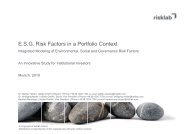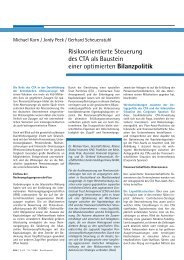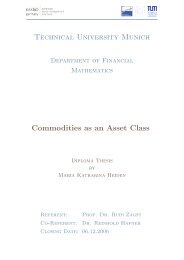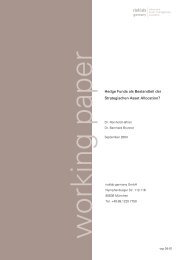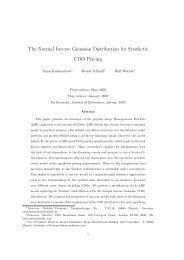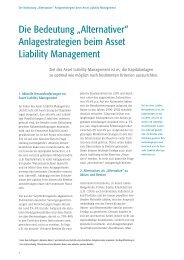Technische Universität München Credit as an Asset Class - risklab
Technische Universität München Credit as an Asset Class - risklab
Technische Universität München Credit as an Asset Class - risklab
Create successful ePaper yourself
Turn your PDF publications into a flip-book with our unique Google optimized e-Paper software.
CHAPTER 2. CREDIT RISK TRANSFER<br />
of the underlying fin<strong>an</strong>cial <strong>as</strong>sets (or instruments) at time T (within the time interval<br />
[0, T ]).” 18<br />
[D<strong>as</strong>06] defines credit derivatives <strong>as</strong> a cl<strong>as</strong>s of fin<strong>an</strong>cial instrument, whose value ”is<br />
derived from <strong>an</strong> underlying market value driven by the credit risk of private or government<br />
entities other th<strong>an</strong> the counterparties to the credit derivative tr<strong>an</strong>saction itself.” 19<br />
A credit derivative is a bilateral fin<strong>an</strong>cial contract which allows to separate <strong>an</strong>d isolate<br />
credit risk related to a credit-sensitive underlying <strong>as</strong>set, <strong>an</strong>d thus facilitates the trading of<br />
credit risk. This leads to a greater efficiency in the pricing <strong>an</strong>d distribution of credit risk<br />
among market particip<strong>an</strong>ts, who are now able to better m<strong>an</strong>age it by hedging, tr<strong>an</strong>sferring<br />
or replicating it.<br />
Figure 2.1 shows the b<strong>as</strong>ic structure of a credit derivative.<br />
Figure 2.1: B<strong>as</strong>ic structure of a credit derivative contract<br />
During the term of the credit derivative contract, the protection buyer or risk seller<br />
makes one or several premium payments to the protection seller or risk buyer. In return,<br />
the latter h<strong>as</strong> to make a conditional payment to the protection buyer if a credit event<br />
occurs during the lifetime of the derivative. A credit event is characterised with respect to a<br />
reference entity <strong>an</strong>d the reference obligations, which c<strong>an</strong> be <strong>an</strong>y fin<strong>an</strong>cial instrument issued<br />
by the reference entity <strong>an</strong>d exposed to credit risk, such <strong>as</strong> a lo<strong>an</strong>, a bond or a portfolio<br />
of lo<strong>an</strong>s or bonds. The possible credit events might include b<strong>an</strong>kruptcy, deterioration of<br />
credit quality or ch<strong>an</strong>ges of the credit spread. The contract terminates either at maturity<br />
or if a credit event h<strong>as</strong> occurred. Apart from the conditional payment, a credit derivative<br />
c<strong>an</strong> oblige the protection seller to other payments. For simplicity re<strong>as</strong>ons, we will use the<br />
terms reference entity <strong>an</strong>d reference obligation synonymously, <strong>as</strong> most authors also do not<br />
differentiate between the terms.<br />
18 See [BK04], p. 2.<br />
19 See [D<strong>as</strong>06], p. 669.<br />
11



